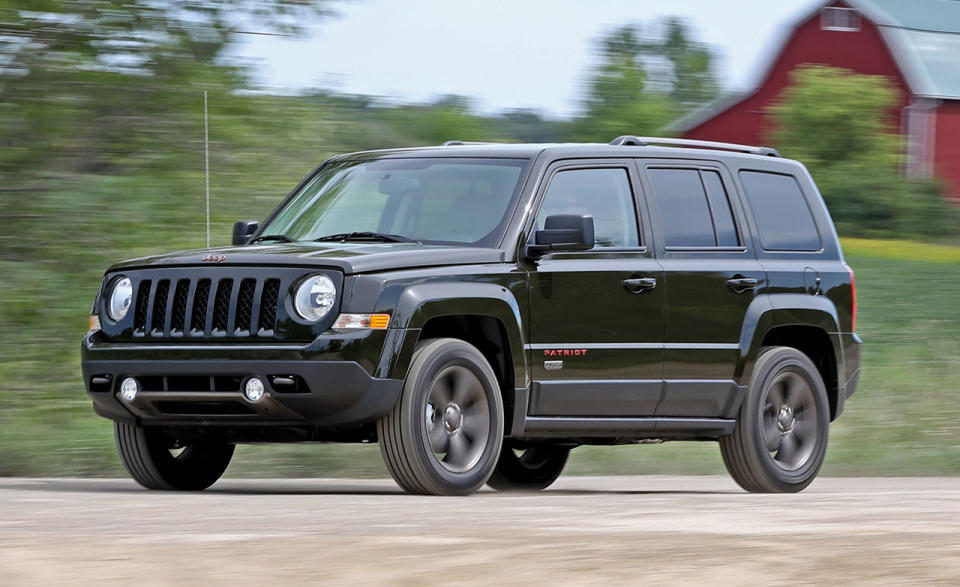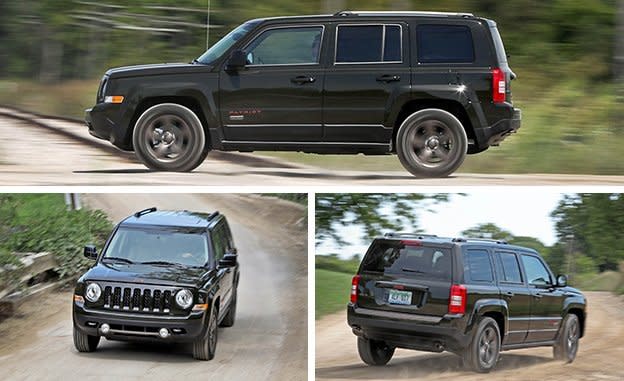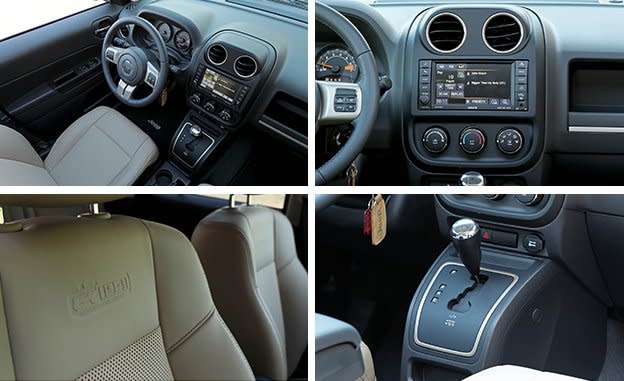2016 Jeep Patriot 4x4 Automatic

As the least expensive model in the Jeep lineup eligible to wear the Trail Rated badge, the Patriot has its work cut out for it. Launched as a 2007 model, this compact SUV shares its platform with the Jeep Compass and the unloved and departed Dodge Caliber, yet it does a fair job of hiding those family ties under traditional squared-off Jeep styling cues. While the point of the Compass escapes many of us, the Patriot's mission—offering buyers a low-cost entry to the Jeep look and lifestyle—is crystal clear.
Both the Patriot and the Compass are slated to be replaced with a single, as yet unnamed model for 2018. The Patriot is still selling well even as it enters its 11th model year (yes, there are 2017 Patriots, essentially unchanged from the 2016 edition tested here), proving that the product planners were on target when they decided to enter what later became one of the industry’s hottest market segments.
Tit for Tat
As with our recent test of a 2016 Jeep Compass, the Patriot is nothing if not a bundle of contradictions. It includes cruise control as standard, yet connecting a phone to the standard Bluetooth system requires engaging in a lengthy two-way dialogue with the Voice Command system; the steering wheel tilts but does not telescope; the 60/40 split rear seats have all the sculpting and bolstering of a park bench, yet, thanks in part to ample foam padding, they offer reasonable comfort for passengers of all sizes. Jeep wisely resisted the urge to add some cheap sizzle to the instrument panel with a half-baked digital setup and went with basic white-on-black round instruments, yet the top of the dash—and much of the interior—is constructed of criminally cheap-looking plastic that smacks of the cost-cutting priorities set in the mercifully short period when Cerberus owned Chrysler. In short, the Patriot team had to make hard decisions in order to bring an off-road-capable Jeep vehicle to market at a competitive price. The rectilinear styling delivers a fairly roomy interior and a generous cargo hold, practicalities that remain a strength for the Patriot when compared with fresher crossover SUVs in this price range.
Patriots now are offered in just two trim levels: Sport and Latitude. Our four-wheel-drive Sport test car was equipped with the 75th Anniversary package (called the 2GK Quick Order package in dealer speak; it adds $1430 to the price), which brings a Recon Green and Bronze color scheme and a badging treatment similar to the one on our aforementioned Compass test car. Other niceties bundled with the package include a power sunroof, a leather-wrapped steering wheel, remote start, bronze 17-inch wheels, and the 178-hp 2.4-liter inline-four-cylinder engine. The base engine is a 158-hp 2.0-liter four. Opting for the 75th Anniversary package, however, mandates a few additional options, namely air conditioning ($1375) and the Power Value Group ($2045), which includes keyless entry, automatic headlamps, power heated mirrors, illuminated entry, and automatic locking. Finally, our test car also had a backup camera ($995) and the six-speed automatic transmission ($1450) in place of the standard continuously variable unit.

The as-tested price, then, was $7295 higher than the $20,690 base price for a 4x4 Patriot, or about the same as a similarly equipped 75th Anniversary edition of Jeep’s fresher but smaller Renegade with four-wheel drive. (Front-wheel-drive Patriots start at $18,990.) While we understand the marketing value of an attention-catching sub-$20K MSRP ($19,695 before the $995 destination fee), many of the features added to this Patriot as piecemeal “options” are included as standard kit at the base price of competitor vehicles. Were we writing the check, we’d skip the anniversary package and its oxymoronic “mandatory options” and instead spring for a 2.4-liter Sport SE with A/C and the six-speed automatic for $24,310; the difference of more than $3000 is significant in this budget-minded price segment. Keep in mind, though, that the Patriot is not long for this world—the 2018 replacement is expected to make its debut at the Los Angeles auto show in November and arrive in dealerships in the first quarter of next year, after which the remaining inventory of 2017 Patriots will move to the day-old rack. Expect bargains.
Drive It Home?
If the price and packaging still look appealing on paper, it’s more difficult to rationalize the Patriot’s on-road behavior. It’s just plain old, and it feels like it. Put your foot down, and the six-speed auto allows the inline-four to swing for the bleachers, holding on to gears until redline. The engine spent so much time spinning at high revs that at least one staffer assumed it had the base CVT rather than the optional planetary-gear automatic. Four-wheel drive in this example came by way of Jeep’s Freedom Drive I active electronic full-time system that diverts torque to the rear wheels when front slip is detected. A selectable “lock” feature splits the torque distribution between front and rear axles, but no low range is included. For that—and the Trail Rated badge—you’d need to opt for Freedom Drive II ($1250) with its off-road mode, but that locks you in to the CVT, since the base five-speed manual and the six-speed automatic aren’t offered with that system.
Our sense of modest performance in traffic was confirmed at the track, where the zero-to-60-mph sprint consumed 9.7 seconds and the quarter-mile took 17.4 seconds with a trap speed of 81 mph. Those figures are nearly identical to the numbers produced by its Compass fraternal twin and slower than those of the last Jeep Wrangler Unlimited we tested (8.4 and 16.6 seconds), a vehicle that makes the Patriot appear to be an example of cutting-edge technology. The Patriot did outrun the Subaru Crosstrek 2.0i, a similarly priced vehicle that more or less fits into the same sub-segment, which required 10.3 and 17.9 seconds to complete the tests. Given the amount of time we spent with the gas pedal on the floor, we were mildly impressed with this Patriot’s 21-mpg observed fuel economy, just 1 mpg shy of the EPA combined rating.

Once up to speed, the Patriot knocks down the miles acceptably. With an interior sound level of just 70 decibels at 70 mph and no evidence of squeaks and rattles (not the case in some earlier model years), it’s easy to maintain a conversation—until the need to pass arises and the moan of the 2.4 reaching for revs invades the cabin. The 265/65-17 Goodyear Wrangler SR A tires sing a little on coarse concrete but sail silently across asphalt. Likewise, the suspension displays the Patriot’s characteristic “good enough for some of the people most of the time” properties. While most pothole impacts are muted, if not entirely negated, hitting a major road crater directly resonates through the passenger compartment as if the dampers had just poked free of their upper mounts.
Stopping performance is average for a class in which outstanding brakes are a rarity. Stepping hard on the brake pedal at 70 mph reveals firm initial bite but otherwise ambivalent pedal feel, while taking 194 feet to come to a stop. The Subaru did it in only 186 feet; the anachronistic Wrangler, on the other hand, took all of 209 feet. Other dynamic traits, such as transient response, grip, and steering feedback, all remind us that this is a decade-old model. With just 0.73 g of lateral grip, vague steering, and persistent understeer, this isn’t a mount that encourages the driver to challenge freeway ramps. In true Jeep tradition, it’s better suited to dirt roads and trails.
In a rapidly expanding sea of modern, versatile compact and mid-size crossovers, the Patriot stands out as a relic from another era. Not everyone is in a rush to embrace the latest trends, though; for them, this last Patriot may represent an opportunity to grab a Jeep on the cheap.
Specifications >
VEHICLE TYPE: front-engine, front- or 4-wheel-drive, 5-passenger, 4-door hatchback
PRICE AS TESTED: $27,985 (base price: $20,690)
ENGINE TYPE: DOHC 16-valve inline-4, aluminum block and head, direct fuel injection
Displacement: 144 cu in, 2360 cc
Power: 172 hp @ 6000 rpm
Torque: 165 lb-ft @ 4400 rpm
TRANSMISSION: 6-speed automatic with manual shifting mode
DIMENSIONS:
Wheelbase: 103.7 in
Length: 173.8 in
Width: 69.2 in Height: 66.8 in
Passenger volume: 102 cu ft
Cargo volume: 23 cu ft
Curb weight: 3422 lb
C/D TEST RESULTS:
Zero to 60 mph: 9.7 sec
Zero to 100 mph: 31.0 sec
Zero to 110 mph: 49.5 sec
Rolling start, 5–60 mph: 10.5 sec
Top gear, 30–50 mph: 5.0 sec
Top gear, 50–70 mph: 7.7 sec
Standing ¼-mile: 17.4 sec @ 81 mph
Top speed (redline limited): 111 mph
Braking, 70–0 mph: 194 ft
Roadholding, 300-ft-dia skidpad: 0.73 g
FUEL ECONOMY:
EPA city/highway driving: 20/26 mpg
C/D observed: 21 mpg

 Yahoo Autos
Yahoo Autos